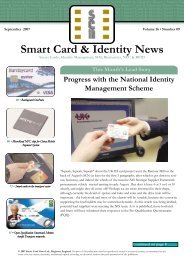Smart Card & Identity News A New Flavour for eCash
Smart Card & Identity News A New Flavour for eCash
Smart Card & Identity News A New Flavour for eCash
You also want an ePaper? Increase the reach of your titles
YUMPU automatically turns print PDFs into web optimized ePapers that Google loves.
Events Diary<br />
May 2012<br />
14-17 Mobile Money 2012 - http://www.mobile-money-gateway.com/event/mobile-moneyafrica-2012v<br />
15-16 <strong>Card</strong>s & Payments Middle East- http://www.terrapinn.com/exhibition/cards-andpayments-middle-east/index.stm<br />
21-23 Security Document World 2012, Queen Elizabeth II Conference Centre, London, -<br />
http://www.sciencemediapartners.com<br />
Source: www.smartcard.co.uk/calendar/<br />
…. Continued from page 1<br />
The Royal Canadian Mint has gone <strong>for</strong> the third approach by adopting a direct asset transfer model. There are<br />
advantages and disadvantages of each approach which we will look at in more detail.<br />
The 4-Party model is that commonly seen today when paying with a credit or debit card. The bank holds the<br />
consumer’s accounts <strong>for</strong> which funds can be either pre-paid or post-paid. The bank that holds the account is<br />
called the Issuer because it traditionally issues a card which allows the consumer to access their account. The<br />
consumer is called the <strong>Card</strong>Holder because they traditionally hold the card that gives access to the account. The<br />
Merchant is the provider of goods or services to the cardholder in exchange <strong>for</strong> payment. The fourth member<br />
of the set is the merchant Acquirer which is the bank or service provider that acquires the transactions <strong>for</strong><br />
clearing and settlement within the networks of the financial institutions. In other words the Acquirer has to get<br />
the funds from the Issuer on behalf of the merchant.<br />
It doesn’t take very long to appreciate that all these various parties have costs and there<strong>for</strong>e want to charge fees<br />
<strong>for</strong> their payment services. The Issuer charges an Interchange fee <strong>for</strong> the costs of managing the cardholder<br />
relationship, the acquirer charges <strong>for</strong> the costs of managing the transaction (which will include an authentication<br />
and authorization process) and the network processing costs applied by the payment operators such as Visa and<br />
Mastercard. All these fees of course are accumulated and get applied to the merchant, sometimes called the<br />
merchant discount fee. These fees are applied per transaction and <strong>for</strong> a small merchant may be 3% or more <strong>for</strong> a<br />
credit card transaction. Debit card transactions are usually a fixed fee per transaction and <strong>for</strong> a small merchant<br />
may be 25 pence or more per transaction.<br />
It is immediately obvious that this 4-P model is unlikely to be economically feasible <strong>for</strong> very low value<br />
transactions of a few pounds or less. In the cash world these small value payments dominate the market.<br />
So the question is how can we reduce the cost of these 4-P model transactions. That’s not easy and the approach<br />
adopted by the payment operators to date has been to remove the on-line authentication/authorization step.<br />
Effectively what the Issuers are doing is taking the risk on an off-line transaction if the value is low enough (e.g<br />
$20 or less). However ignoring the details <strong>for</strong> the moment it is clear that there is an increased risk and only a part<br />
of the costs have been reduced. In addition you would want to minimise the risk of card fraud and at the least<br />
would want the consumer to be using a secure smart card. This is really not a place <strong>for</strong> a magnetic stripe card.<br />
From the consumers point of view there is an advantage because the Issuer often has to bear part of the<br />
transaction risk under the various consumer protection laws and of course if you lose your card you don’t lose<br />
your money (assuming you report it to the bank).<br />
You don’t need a degree in economics to realize that this still isn’t going to work <strong>for</strong> transactions with a value of<br />
say less than say $5 and in the virtual world of the internet there is a need to handle transactions perhaps less<br />
than $1. The ultimate test is whether you can handle a transaction of 1 cent? Not by the 4-P model!<br />
<strong>Smart</strong> <strong>Card</strong> & <strong>Identity</strong> <strong><strong>New</strong>s</strong> • March 2012<br />
4
















